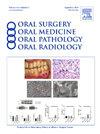no -1与DOG-1免疫组化染色在涎腺腺泡细胞癌诊断中的比较
IF 1.9
3区 医学
Q2 DENTISTRY, ORAL SURGERY & MEDICINE
Oral Surgery Oral Medicine Oral Pathology Oral Radiology
Pub Date : 2025-07-21
DOI:10.1016/j.oooo.2025.04.061
引用次数: 0
摘要
唾液腺腺泡细胞癌(ACC)由于其广泛的组织形态学变异性,提出了诊断挑战。DOG-1在ACC诊断中具有敏感性,但不具有特异性。DOG-1阳性见于正常唾液腺泡、多形性腺癌和多形性腺瘤的管腔细胞。最近在ACC中发现了一种新的重排t(4;9) (q13;q31)导致核受体亚家族4A组成员3 (NR4A3)的上调。利用针对这种重排的抗体,神经元源性孤儿受体1 (NOR-1)进行免疫染色,已被研究用于ACC的可靠诊断。本研究的目的是评价和比较NOR-1抗体与DOG-1抗体的性能。材料和方法对2000年至2022年期间佛罗里达大学口腔病理活检服务数据库进行irb批准的回顾性检索。采用市售抗体no -1 (sc-393902 [H-7], Santa Cruz Biotechnology Inc.)对所有纳入的病例进行DOG-1、mammaglobin和NR4A3免疫组化染色,并进行适当的对照。结果本组共纳入8例低级别ACC。患者年龄在40 ~ 95岁之间,性别分布均匀。1例来自腮腺,其余均来自颊、唇小唾液腺。5例为常规实性变异体,2例为微囊性变异体,1例为乳头状囊性变异体。8例患者中有6例nor1阳性,DOG-1阳性,8例患者中有5例。所有病例均为乳蛋白阴性。结论在本组病例中,snor1染色比DOG-1染色对ACC的诊断更敏感。然而,建议在更多病例的其他研究中对该标记物进行评估。本文章由计算机程序翻译,如有差异,请以英文原文为准。
Comparison between NOR-1 and DOG-1 immunohistochemistry staining in the diagnosis of salivary acinic cell carcinoma
Introduction
Acinic cell carcinoma (ACC) of the salivary gland presents diagnostic challenges due to its wide histomorphological variability. DOG-1 has been shown to be sensitive in the diagnosis of ACC but is not specific. DOG-1 positivity can be seen in normal salivary acini, polymorphous adenocarcinoma, and luminal cells of pleomorphic adenoma. A novel rearrangement t(4;9) (q13;q31) leading to the upregulation of nuclear receptor subfamily 4 group A member 3 (NR4A3) has recently been identified in ACC. Immunostaining using an antibody targeting this rearrangement, neuron-derived orphan receptor 1 (NOR-1), has been investigated for reliable diagnosis of ACC. The purpose of this study was to evaluate and compare the performance of NOR-1 antibody with DOG-1.
Materials and Methods
An IRB-approved retrospective search of the University of Florida Oral Pathology biopsy service database between 2000 and 2022 was performed for ACC cases. DOG-1, mammaglobin, and NR4A3 immunohistochemical staining was performed on all included cases with appropriate control using the commercially available antibody NOR-1 (sc-393902 [H-7], Santa Cruz Biotechnology Inc.).
Results
Eight cases of low-grade ACC were included. Patient age ranged between 40 and 95 years with equal gender distribution. One case was from parotid gland while all other cases were from buccal and labial minor salivary glands. Five cases were conventional solid variant, two were microcystic, and one papillary-cystic variants. Six cases out of eight stained positive for NOR-1 with variable intensity, while DOG-1 stained five cases out of eight. All cases were negative for mammaglobin.
Conclusions
NOR-1 staining revealed more sensitivity than DOG-1 for diagnosis of ACC within our case series. However, evaluation of this marker in additional studies with larger number of cases is recommended.
求助全文
通过发布文献求助,成功后即可免费获取论文全文。
去求助
来源期刊

Oral Surgery Oral Medicine Oral Pathology Oral Radiology
DENTISTRY, ORAL SURGERY & MEDICINE-
CiteScore
3.80
自引率
6.90%
发文量
1217
审稿时长
2-4 weeks
期刊介绍:
Oral Surgery, Oral Medicine, Oral Pathology and Oral Radiology is required reading for anyone in the fields of oral surgery, oral medicine, oral pathology, oral radiology or advanced general practice dentistry. It is the only major dental journal that provides a practical and complete overview of the medical and surgical techniques of dental practice in four areas. Topics covered include such current issues as dental implants, treatment of HIV-infected patients, and evaluation and treatment of TMJ disorders. The official publication for nine societies, the Journal is recommended for initial purchase in the Brandon Hill study, Selected List of Books and Journals for the Small Medical Library.
 求助内容:
求助内容: 应助结果提醒方式:
应助结果提醒方式:


